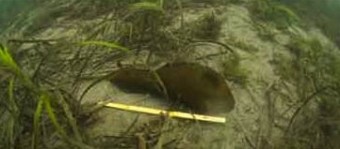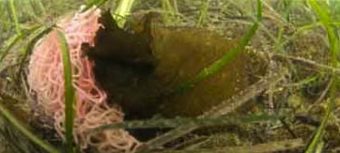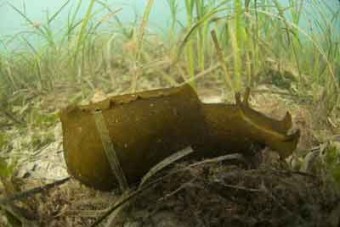Large Helford Sea-hares – Aplysia depilans


 On Tuesday 16th October 2007 Tony Sutton was diving on the eelgrass bed at 5.7m depth in the Helford VMCA when he came across some exceptionally large greenish brown sea-hares (35cm) which attracted his attention. When he returned a few days later with his camera he was able to take some excellent pictures which indicated the species Aplysia depilans. Confirmation of this identification was established by Dr Paul Gainey when one of the animals was taken briefly from the water.
On Tuesday 16th October 2007 Tony Sutton was diving on the eelgrass bed at 5.7m depth in the Helford VMCA when he came across some exceptionally large greenish brown sea-hares (35cm) which attracted his attention. When he returned a few days later with his camera he was able to take some excellent pictures which indicated the species Aplysia depilans. Confirmation of this identification was established by Dr Paul Gainey when one of the animals was taken briefly from the water.
The commonest species of sea-hare in our shallow water is Aplysia punctata which can reach some 20cm extended length but is more usually below 10cm. They are typically found on the sea-bed grazing on algae, often amongst eelgrass where they leave their yellowish pink egg strings during the autumn-spring breeding season.
Sea hare A. depilans photograph by Tony Sutton
Sea hare A. depilans with eggs photograph by Tony Sutton
More impressive are the other, much less common, species Aplysia depilans and Aplysia fasciata the former is known to reach 30cm and the latter can be even larger at around 40cm. Both are associated with the warmer seas of the Channel Islands, Atlantic France and the Mediterranean as well as Madeira and West Africa where A. fasciata in particular can be observed swimming more freely than our A. punctata. Two large parapodial lobes and the broad “slug-like” body pulsate rhythmically carrying the animal through the water with a flapping motion.
Tony was fortunate to find some animals with egg masses. Could this be linked to the significantly warmer sea temperatures of recent years? In 1976, the Opisthobranch expert, T E Thompson, remarked that it is not known whether Aplysia depilans ever breeds in British waters.
Recent reports of large sea hares from other sites include Poole Harbour – one weighing 1.5kg Aplysia fasciata still swimming happily, grazing on sea lettuce Ulva lactuca at the National Marine Aquarium and producing egg masses. Four more, probably of the same species, were caught and released in Poole by local fishermen. The Blue Reef Aquarium, Newquay has also received one. Other reports, some of which could have been of either of the larger species, have been received from Mevagissey, Falmouth, Beesands, Tor Cross, Nos Mayo, Devon and St Helier, Jersey.
Sea hare A. depilans photograph by Tony Sutton
How can you tell the difference between the two larger species by the shore – not easily and dissection seems inappropriate. Try looking, especially underwater, at the two large parapodial lobes mentioned above which are free all the way to the end of the body in Aplysia fasciata but in Aplysia depilans they are joined rather high posteriorly – see Tony’s photos. The oral tentacles at the front are more frilled in A. fasciata. Try to take photos that show these characteristics! These are not easy to see if you find something looking like a large lump of gelatinous liver on the shore but could be seen if a freshly stranded animal was placed in a bucket of sea water.
All sightings of these larger species would be of great interest and Dr Paul Gainey would try to visit any find within range or as far as practicable Tel: 01326 372 840.
Dr Pamela E Tompsett
Extract from HVMCA newsletter No.35 Autumn 2007







